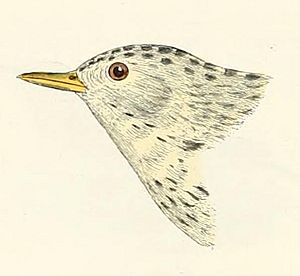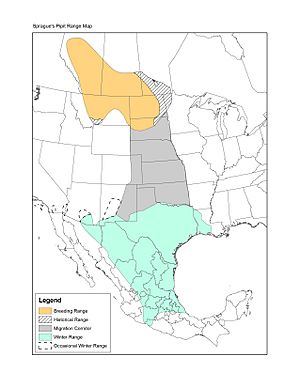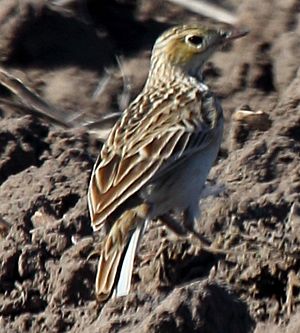Sprague's pipit facts for kids
Quick facts for kids Sprague's pipit |
|
|---|---|
 |
|
| Conservation status | |
| Scientific classification | |
| Genus: |
Anthus
|
| Species: |
spragueii
|
 |
|
| Range of Sprague's pipit | |
The Sprague's Pipit (Anthus spragueii) is a small songbird. It belongs to the Motacillidae family. These birds make their homes in the short and mixed-grass prairies of North America. They are migratory birds. This means they fly south for the winter. They spend their winters in the southwestern United States and northern Mexico.
Sprague's Pipits are special among songbirds. They sing high up in the sky! This is a bit like how a goldfinch or skylark sings. People often know they are around because of their unique song. It sounds like a descending tune heard from above. It is harder to spot them on the ground. Both male and female pipits look very similar. They have colors that help them blend in. They are a buffy brown with darker streaks. They also have thin beaks and pinkish to yellow legs. Sprague's Pipits usually live in native grasslands during the summer. These are found in the central prairies of the United States and Canada.
Contents
What Does a Sprague's Pipit Look Like?
Sprague's Pipits are small birds. Here are some of their measurements:
- Length: They are about 5.9 to 6.7 inches (15 to 17 cm) long.
- Weight: They weigh about 0.6 to 0.9 ounces (18.2 to 27 grams).
- Wingspan: Their wings can spread up to 10 inches (25.4 cm) wide.
Where Do Sprague's Pipits Live?
Sprague's Pipits are found in the central northern Great Plains of North America. They live in areas with mixed or short grass prairies.
Summer Homes
In Canada, Sprague's Pipits breed in southern Alberta, southern Saskatchewan, and southwest Manitoba. In the United States, they breed in northeastern and central Montana. They also live in western and central North Dakota. You can find them in northwest South Dakota and the Red River Valley of Minnesota.
Winter Homes
For winter, Sprague's Pipits fly to the southwestern United States and northern Mexico. In the United States, they are found in southern California (sometimes). They also live in south-central and southeastern Arizona, southern New Mexico, and central and eastern Texas. Sometimes, they are seen in southern Kansas and southern Oklahoma. Very rarely, they appear in southern Missouri, Tennessee, and northwestern Mississippi. They also fly south through Arkansas and Louisiana. In 2016, one was even seen in Connecticut. This shows they can sometimes wander to new places.
In Mexico, they live in the middle of the country. This includes northeastern Sonora and Nuevo León south to Zacatecas and San Luis Potosí. They are also found along the Atlantic Coast from Tamaulipas to central Veracruz.
Protecting Sprague's Pipits
Sprague's Pipits are a species that needs our help. Their numbers have been decreasing.
Conservation Status
In Canada, Sprague's Pipits were listed as "threatened" in 1999. This status was checked again and confirmed in 2000. They were officially listed under the Species at Risk Act (SARA) as "threatened" in 2003. In the United States, they are being considered for listing as "endangered" or "threatened." This would happen under the Endangered Species Act of 1973.
Their Habitat
Sprague's Pipits like to breed in places that humans have not disturbed much. This means areas with very little grazing by animals, hay cutting, or other human building. They build their nests on the ground. They use standing dead plants to create a roof over their nest.
Reproduction and Life Cycle
Sprague's Pipits start breeding in late April. They continue until mid to late August. Their nests are small cups made of grass. These nests are found on the ground. They fold dead plants over the nest to make a canopy. There is only one way to get into the nest.
Female pipits usually lay four to six eggs. The eggs hatch after about 13 to 14 days. Sometimes, pipits will build a new nest and have a second group of chicks. It is also possible for one male to mate with more than one female. However, most Sprague's Pipits only have one group of chicks per year.
What Do Sprague's Pipits Eat?
Sprague's Pipits eat different kinds of insects and spiders. Sometimes, they also eat seeds. During the breeding season, adult pipits eat almost only insects. They also feed their young chicks insects.
Images for kids
-
A Sprague's Pipit nest with two eggs and four newly hatched chicks. This photo was taken at CFB Suffield.
See also
 In Spanish: Bisbita llanero para niños
In Spanish: Bisbita llanero para niños




